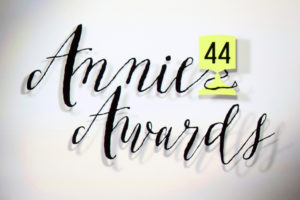 Put on by ASIFA-Hollywood, animation’s top organizational body, the February 5 Annies, again held at UCLA’s Royce Hall, showcased the best in the many media across which animation has its demonstrable wingspan.
Put on by ASIFA-Hollywood, animation’s top organizational body, the February 5 Annies, again held at UCLA’s Royce Hall, showcased the best in the many media across which animation has its demonstrable wingspan.
For one, Max Karli, the Annie and Oscar-nominated My Life as a Zucchini producer, explained the 10-year journey to get his film created with practical sets and puppets. “The director read the book and thought ‘Okay, I want to do a film,’” Karli recalled of the project’s origins, circa 2007. We came in six years ago, finished the script, financed the film, and then for four years lasted the production of the film.”
Hailing from Switzerland, Karli and his team set up a makeshift animation studio in a warehouse in France where a group of 150 artists created the work for the project. Half of the team also worked in Switzerland. “We had animators come from all over the world,” Karli added. “From the United States, Spain, New Zealand. Ever since the opening in Cannes, we saw something special was happening and the people over here are liking the film so much. It’s such a great thing because it proves the point of film is universal.”
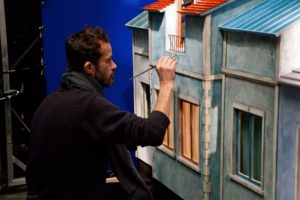
Frank Gladstone, executive director of ASIFA-Hollywood noted the international feeling at the 2017 Annies, the 44th edition of the awards show. “Well, we’ve been trying to do that for years now,” Gladstone unveiled. “We started focusing on not only our own neighborhood, but neighborhoods all over, worldwide neighborhoods. And I’m gratified to see it really starting to percolate up. The idea was that we were going to go wider, and we have the best feature – independent, now, and we’re seeing shorts from all over. To me, that’s a very important thing.”
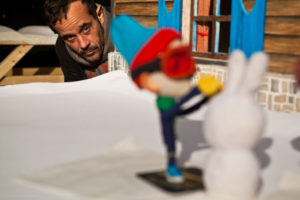
Actress Jenna Elfman was on hand as a presenter but also has recent experience as a live performer in the world of animation. “As a performer, you have to take your imagination and crank it up a million notches, because, like in my new show Imaginary Mary, I’m acting and I have an imaginary friend that’s a CGI character, so there’s no green screen or green ball,” she explained. “We have a puppet we rehearse with, and then we’ll do one take with the puppet for reference for the animators, and then that puppet goes away, and I film with nothing. And I often have seven or eight eyelines in one scene… and I’m moving around. And I have to remember dimension points and different eyelines; then if I’m in the scene with other actors who don’t see her, I have to manage my dynamic with her and them in the same moments while remembering the eyelines and making it funny.”
Such a challenge is surely not to all tastes, but Elfman felt like she was up for the task. “I’ve had so much experience in my career that I felt prepared me for this, so it’s a nice new challenge and definitely keeps me on my toes, and I felt ready for it,” she said.
Music touches the animation world just as significantly as it contributes to live-action films. Cases in point are Alexis Harte and J.J. Wiesler, songwriters and Annie winners for the short film Pearl. “It’s all based around a song,” said Harte. “It’s the story of a father and a daughter in a car, and it’s the story of the father passing on his gifts to his daughter.”
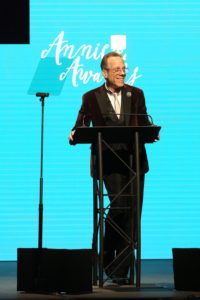
For Pearl, directed by Patrick Osbourne, the songwriting and film scoring process took just over a year. “When you do an original song for an animation,” Wiesler continued, “you have to write the song first because the animators need to animate to the song. We actually wrote the song very early—we made some very small edits along the way, and we spent the majority of production dealing with the spherical audio aspects of a virtual reality experience. In Pearl, you’re in the passenger seat of a car, and there’s a story happening all around you, and we had to work to build the sound engine that makes that sound feel immersive.”
To actuate the sound and music for Pearl, Harte and Wiesler utilized a process called ‘Ambisonics’ to create full spherical sound attuned to a virtual reality experience.
Also winning for Pearl was Rachid El Guerrab, executive producer for Google Spotlight Stories. El Guerrab has already supervised nine short Google projects including Pearl. “We were trying to see what kind of entertainment films we could make on a phone, that you can only watch on a phone,” he said. “So these are basically VR [virtual reality] and 360º films. How does anybody make a film where they give the camera to the viewer? What’s the film language? How are they cut?”
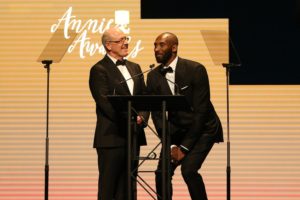
With production created on Google’s primary Mountain View, California campus plus additional work in San Francisco at Evil Eye Pictures, El Guerrab explained that Pearl’s running time is not limited because the work is interactive. “It’ll wait for you if you’re not watching,” he said, “so you can watch it from five minutes to ten minutes. You can watch it on a phone, tablet, with Cardboard, with Daydream, with the VR headset — all formats, and we made it theatrical as well.”
Animation director legend Henry Selick was also in attendance, though not nominated, as he is currently ramping up his next project. Of course, Nightmare Before Christmas and Coraline are two of stop-motion puppet-oriented animation’s greatest projects. “Coraline and Nightmare are the two best things that I’ve done,” he conveyed, noting that Nightmare lives on as an evergreen classic for both Halloween and Christmas seasons. “It’s just the combination of Tim [Burton]’s brilliant idea, Danny [Elfman]’s songs, and my team of animators. We put in our hearts and souls; it was a very joyful experience. I was on it three-and-a-half years, but the actual production was a-year-and-a-half. There was virtually no pain making it, and that shows on screen. It’s a classic story, and I don’t think it can be topped.”
Surprising the Annies crowd, former Los Angeles Lakers player Kobe Bryant appeared as a presenter on behalf of his new short film Dear Basketball. “It’s been absolutely wonderful,” said Bryant said on the red carpet of his post-basketball creative life. “You wake up in the morning and you think of great stories to tell from the things that appear to you in your dreams, and you wake up eager to work. In this line of work, I don’t have to rest — when it comes to sports, you have to let your body recover. When it comes to imagination and creation, it’s non-stop, and it’s such a marvelous thing. It’s been a dream come true.”
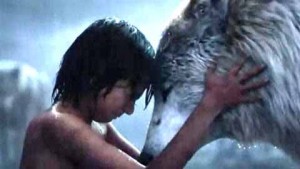
Dear Basketball, overseen by animation veteran Glen Keane, is a five-minute film which will be released later in 2017. “It’s pretty sweet,” added Bryant. “I retire from basketball and immediately focus on producing a short film, animated by Glen Keane and composed by John Williams. It doesn’t get any better.”
Another Annie went to The Jungle Book’s animation supervisor Andrew R. Jones. “As animation supervisor, I had to keep track of 78 different species of animals,” Jones said. “And all of them had to look to the quality of the ‘hero’ characters. If anyone dropped below that quality, we’d be screwed; so, we really had to push the boundaries of all them, while, at the same time, make sure we’re following what we can with what kind of behavioral references there are for these animals.”
For Jones, Jungle Book was a two-year process with two studios handling the work: The Moving Picture Company in London created two-thirds of the animation with the other third being brought to life by Weta Digital in New Zealand. “It was a collaboration between [director] Jon Favreau and I, the guys at Weta, and the guys at MPC to help get the characters and the emotion of the story,” said Jones.
Forging ahead as an independent stop-motion production studio in Portland Oregon, LAIKA, presided over by Travis Knight, has created significant work in the feature films Coraline, Paranorman, Boxtrolls, and the now Annie and Oscar-nominated Kubo and the Two Strings, also directed by Knight. With Kubo perhaps receiving the most industry praise of any LAIKA project to date, Knight spoke of the company’s ascent to this exultant level. “Right from the beginning, I think our philosophy was two-fold,” he said. “We wanted to take stop motion, a medium that we all loved, and bring it into a new era, bring it to a new generation, make it a vital form of filmmaking. So, what we did was take this age-old art and craft and fuse it with technology, cutting into innovation, which enabled us to tell bigger, more fantastic stories. So, that’s why when you go film to film, the bag of tricks gets bigger and more expansive; it’s because of that philosophy and to innovate and push the medium where it hasn’t been before.”
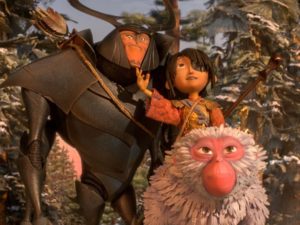
Knight expanded upon LAIKA’s unique creative mission. “There’s another part of the philosophy which is in terms of the stories that we want to tell,” he revealed. “We always want to tell stories that are thought-provoking, emotionally resonant, that take the medium to a place it hasn’t been before. So, when you see from film to film, we always try to do something new aesthetically, visually, tonally, thematically, and so hopefully what people see when a LAIKA film is coming out, they’re excited about it, but they’re not quite sure what they’re going to get.”
350 LAIKA artists were staffed at Kubo’s peak, with over five years from beginning to end to make the film, including over two years of hardcore animation production. “We work in a little insular bubble for years and years at a time up in our shop in Portland, Oregon, and it’s really filmmaking at its purest form,” Knight related. “When you send it out to the world, we really have no idea how people are going to respond, so to have the film be so embraced by fans, critics, by our peers, it makes all that hard work worthwhile.”
Awarded with an Annie for his work on Kubo was animator Jan Maas who created a two-minute sequence in the middle of Kubo which took him eight months to create. “Hundreds of people touched the sequence including visual effects,” he stated, adding that he, “shared it with two other animators and two assistant animators. Usually, you would get briefed on each shot by the director, and then you would do a rehearsal, and then meet again with the director, and then you would shoot it. All year round, there was a lot of trust between the director and the animators, which is very nice because you get a lot of ownership of your animation.”
Lastly, Rich Moore, Annie Winner for Best Director and Best Picture for Zootopia, deferentially spoke of his work on the Walt Disney Animation Studios film. “It just not me who did it; it was 800 different artists,” he said of a film created entirely at the Walt Disney Animation building on the main Disney lot in Burbank, California. “There aren’t too many places like Disney that still have everybody under one roof.”
With development on Zootopia occupying roughly three years, the movie required a five-year total commitment. “The ideas begin with a director,” Moore noted. “We pitch those ideas to John Lasseter, our boss, and he says ‘I like that idea,’ so what starts out as a little idea between two or three people grows and grows and grows, and we are the custodians of that idea through every step of the process.”
Though Disney Animation Studios can be secretive about their creative strategies, Moore boiled the mysterious methodologies down to essentials. “I think it’s the combination of amazing characters in a world that’s fantastic, yet relatable, with stories that we can all understand and find our own place in,” he said. “I think those three things are what make up that ‘Disney magic.’”
Below The Line would also like to extend a special thanks to Gretchen Houser.





